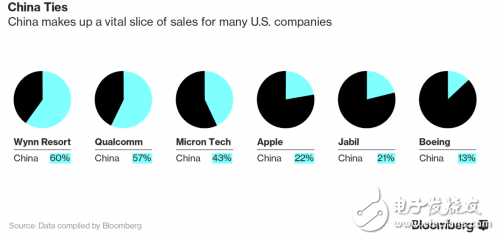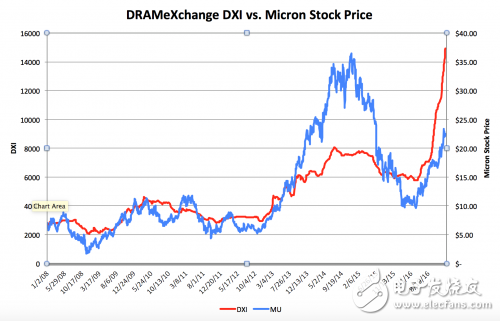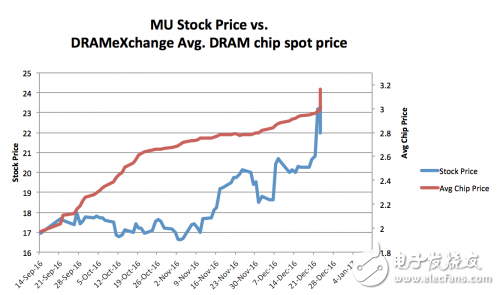Bloomberg was excited to launch such a title on January 5th: When Trump begins, China will launch a review of US companies.
They also use the picture below to describe how much of the company's sales revenue comes from the Chinese market.

This article goes on to suggest that these companies with large share of the Chinese region may be hit by both tax and antitrust investigations.
But it is easy to judge that chip makers Micron and Intel can withstand the impact of the Sino-US trade war. In fact, Intel and Micron are long-term partners, and here we will detail their layout in the international expansion of semiconductor factories and sales.
Intel and Micron have a lot of geographical distribution. Intel's sales are very fragmented and not limited to China.
In the fiscal year ending December 26, 2015, Intel’s sales outside the United States accounted for 80%.
For Micron, sales to customers outside the US accounted for 84% of combined net sales, which is 2016 data.
The two companies also made a good layout for the manufacturing plant. Location is definitely a priority. Below is a list of Intel factories.

This table is very important because
1. Their factory in Dalian is exactly what China needs. It is reported that this factory has already begun to transform the manufacturing of 3D NAND process, and it is very likely that 3D Xpoint production will begin. This is obviously not the behavior of the Chinese government to impose tax and anti-monopoly investigations.
2. If Intel is forced to give up its factory in Dalian, they also have the Fab 42 option. This is a foundry with the largest capacity that has not been launched globally so far.
3. The factory in Buffalo, Israel, used to be a factory of Intel/Numonyx, and later belonged to Micron, and now re-owned at Intel. These players work very closely on many levels.
Below is a list of Micron's factories:

One detail is surprising. The Lehi, Utah-based facility is actually a joint venture between Intel and Micron, with 230 square feet of cleanroom with 200,000 square feet of clean room. I am curious that this factory is the only factory in the world that can produce 3D Xpoint. Obviously they still have a lot of space to expand the capacity of 3D Xpoint.
Just as Intel and Micron exchanged ownership of the Israeli factory, the same thing happened at the Micron Singapore factory. Some experts said that Intel gave the factory to Micron, which is undoubtedly another perspective that allows us to see the closeness of Intel and Micron.
Intel CEO Ke Zaiqi seems to have established close ties with Trump. In the past summer, Korge has been proposing a discussion, which soon became a fundraising event for Trump.
He was also a key figure in the presidential election meeting with the technology giant on December 14, 2016. It is believed that Trump will be willing to listen to Ke Zaiqi’s thoughts before evaluating the trade war with China.
Why is China going to start a trade war based on memory made by Intel and Micron? China is the biggest buyer of DRAM and NAND in the world. I don't think they will start a trade war to make storage more expensive. Punishing the last remaining US producers will make China more dependent on South Korea's Hynix or Samsung's DRAM, as well as Japan's Toshiba and Western Digital's NAND. I don't think China wants to be in such a situation.
As shown, these memory products are now more and more expensive.


Trading at any time is not the best option. It’s even more crazy to trade wars during the current rise in memory prices.
in conclusion
I have been interested in the trade war of memory chips and think that this will not happen because:
1. The CEO of the world's largest chip company still has some influence on the elected militant president;
2. Intel and Micron have a good layout in China, and there are some leading products, such as 3D NAND and 3D Xpoint, which are very much needed in China;
3. China is the world's largest buyer of storage and will not expect the purchase cost of these products to rise;
4. If it is hit by China, Intel and Micron have other factories that can be used to produce memory products currently produced in China.
The On-grid system is connected with utility grid and this system would work only if the grid is available. In case of a power cut, the system will not work and hence the On-grid system is also termed as a Grid-tied system. Grid is required since the inverter needs to be provided a reference voltage and the inverter needs to sync with the grid in order to export energy back into the grid.
On grid systems make sense for locations with no daytime power cut or with less than 2 hrs of daytime power cut. This type of system is apt for reducing your electricity bills since it is cheaper than a battery based system and there is no recurring cost of replacement of panels.
On Grid Solar Inverter,On Grid Solar System,On Grid Solar Power System,On Grid Solar System Price
Wuxi Sunket New Energy Technology Co.,Ltd , https://www.sunketsolar.com